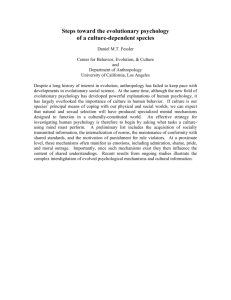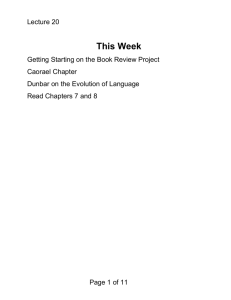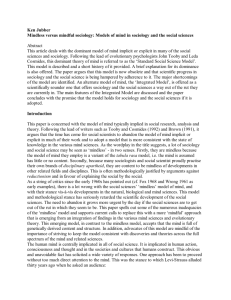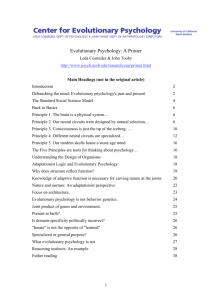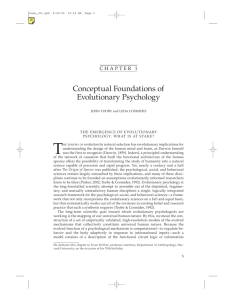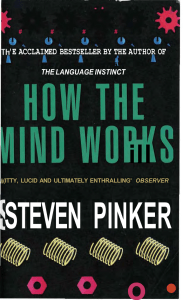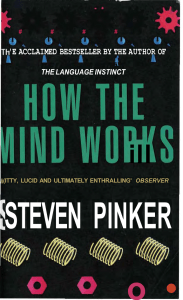Problems with SSSM
advertisement
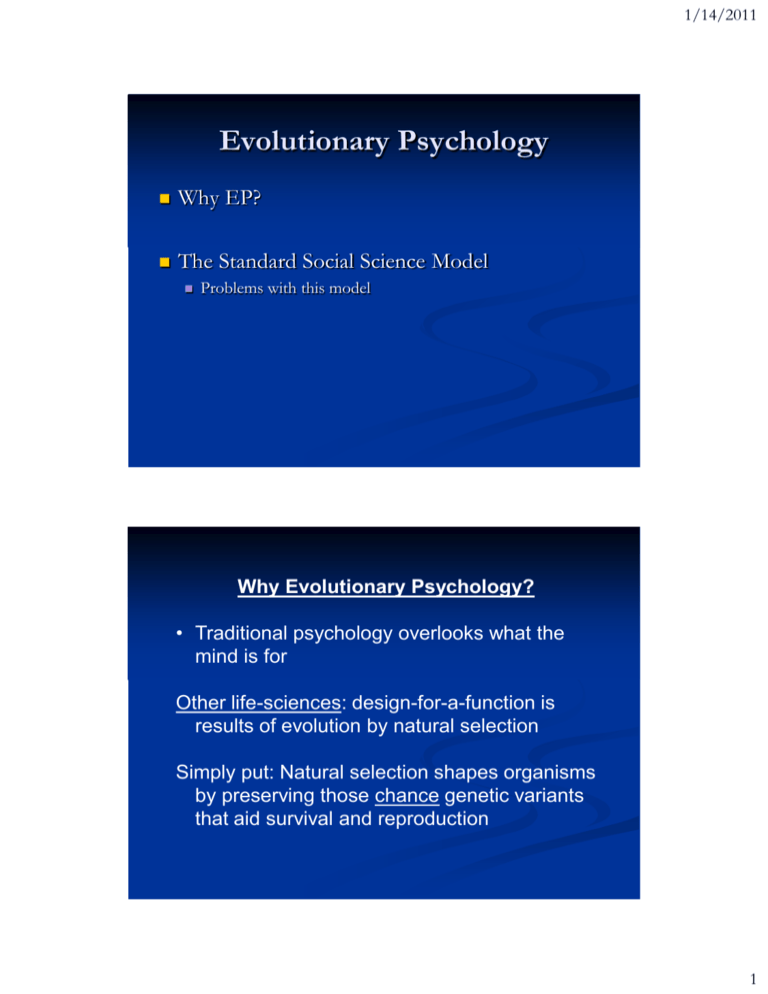
1/14/2011 Evolutionary Psychology Why EP? The Standard Social Science Model Problems with this model Why Evolutionary Psychology? • Traditional psychology overlooks what the mind is for Other life-sciences: design-for-a-function is results of evolution by natural selection Simply put: Natural selection shapes organisms by preserving those chance genetic variants that aid survival and reproduction 1 1/14/2011 Evolution 101 White peppered moth Why Evolutionary Psychology? Why not think about the mind in the same way? That is: the mind is an organ like any other (e.g., liver, heart) 2 1/14/2011 A 1. Group with altruists, busily outcompeting all the other groups. A A A A A S A 2. The selfish individuals in the group are getting the benefit but paying no cost. In the next generation selfish have increased within the group. 3. And now A A altruists are S extinct even S A S S S S S though S S A they’ve S S S helped the group. Why Evolutionary Psychology? Why hasn’t EP developed earlier? 3 1/14/2011 Why Evolutionary Psychology? We are thought of as higher animals who transcend our biological nature The Great Chain of Being God Angels Humans Apes Cats Clams Rocks Today Humans Chimps Clams E Coli The beginning The Selfish-gene and replicators What is Dawkins hypothesis about the beginnings of life and the replication that followed? 4 1/14/2011 Why Evolutionary Psychology? EP is not a subfield of psychology - such as clinical or developmental It is a way of thinking about the entire field But what about the entire field? What’s wrong with it? The Standard Social Science Model Tooby and Cosmides (1992) 1. 2. 3. 4. 5. Many Psychologists hold to the SSSM The blank slate Differences between people arise from differences in experience and cultures Biological constraints on behavior are unimportant: we have few “instincts” or biological drives Learning operates by a small number of general-purpose mechanisms Aim of psychology is to discover how culture and experience, through general learning mechanisms, produce behavior 5 1/14/2011 The Standard Social Science Model Tooby and Cosmides (1992) Critiques 1. SSSM misunderstands nature of development: If something is absent at birth, it is not necessarily learned 2. SSSM draws false dichotomy between nature and nurture: genes and experience work together to guide behavior The Standard Social Science Model Tooby and Cosmides (1992) Critiques 3. General purpose mechanisms cannot explain all behavior: Think of: Pavlov, Skinner, Watson But, general learning can’t account for everything (pigs, racoons, and piggy bank – Misbehavior of Organisms) Instead: Seligman (1971): preparedness Swiss Army Knife, Computer analogy 6 1/14/2011 The Standard Social Science Model Tooby and Cosmides (1992) Critiques 4. SSSM drives a wedge between natural and social sciences If culture is all important, psychology becomes divorced from biology But: biology makes possible everything we do Example: Men desire to mate more often than women: both psychologists and biologists agree. But same effect in most animals! The Standard Social Science Model Tooby and Cosmides (1992) Critiques 5. SSSM lacks an overarching theory of design EP unifies psychology by providing an overarching single theory that allows prediction Why should watching violence on TV cause one to become more violent? Why are family ties important? Why do we care about reputations? Why can’t we be happy all the time? Why do we crave unhealthy foods? 7 1/14/2011 The Standard Social Science Model Tooby and Cosmides (1992) In essence: Psychology asks “what”, “how”, and “when” questions EP asks “why” questions Psychology: When does learning occur? What parts of the brain are involved? Biologists call these proximate questions EP: Why do men and women have different mating strategies? EP’s call these “Ultimate questions” The Standard Social Science Model Tooby and Cosmides (1992) There is a Human Nature Both Psychology and EP agree that people have the same human nature: …but disagree on what that nature is. SSSM: Human nature is a blank slate. Behavior is malleable. We can teach people to be kind and gentle: Evidence? Mead (1928) and the Samoans EP: The Universal People (Don Brown, 1991) Freeman (1983) on Samoans: strict, careful about virginity, men commit rape, family nucleus 8 1/14/2011 The Standard Social Science Model Tooby and Cosmides (1992) People live in groups with rank and status To communicate: they use language and facial expressions They exchange gifts, track favors, dance and make music Live in families centered on mother and children and a man – recognize marriage, kinship, division of labor Modesty about sexual behavior They have supernatural beliefs, theories about disease, death, and misfortune Finally: the Naturalistic Fallacy EP is controversial Used to excuse repression: racism, sexism, and social injustice How? EP explains behavior: It does not justify it We do not reject EP because it can explain the “why” of marital infidelity? The confusion of “is” with “ought” EP provides no moral seal of approval 9 1/14/2011 The Naturalistic Fallacy continued Good example of Naturalistic Fallacy: Social Darwinism (Herbert Spencer, 18201903): Social inequality is justified by evolutionary theory “The poverty of the incapable, the distresses that come upon the imprudent, the starvation of the idea, and those shoulderings aside of the weak by the strong…are the decree of a large, farseeing benevolence” Evolution means progress Shouldn’t meddle with social forces Adopted by Andrew Carnegie: a religious principle 10
